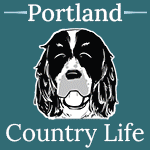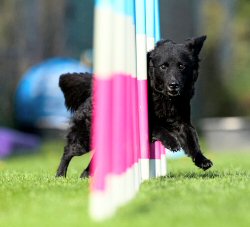|
Co-sponsors of the 2023 Winning Out
Certificates



| |
Give your dogs a break...
 As
sport dog handlers, our focus is usually on how much our dogs should be active.
We think about and discuss with other handlers and trainers how many activities
our sport dog needs, how much training, how many walks and fitness sessions etc.
While this is necessary and important, Krystyna Cisak felt like the subject of
activity has been widely explored, while another key part, which she learned is
crucial for human athletes as a physiotherapist, is left out. That other vital
part we are missing in our sport dog training program is... rest and
regeneration. As
sport dog handlers, our focus is usually on how much our dogs should be active.
We think about and discuss with other handlers and trainers how many activities
our sport dog needs, how much training, how many walks and fitness sessions etc.
While this is necessary and important, Krystyna Cisak felt like the subject of
activity has been widely explored, while another key part, which she learned is
crucial for human athletes as a physiotherapist, is left out. That other vital
part we are missing in our sport dog training program is... rest and
regeneration.
Let's dig
into what sport dog experts have to say.
Rest
does not appear to be a fun topic for social media. As I am part of the
canine influencer community, discussions mainly center around the more exciting
things you do with your dog such as showing, training, competitions, tricks,
travel and other fun stuff. And while that's all super important, I wanted to
put a spotlight on rest and show how important it is for our dogs' performance.
Let's start off with how much our dogs need to sleep... and surprisingly, they
need a lot!
According
to researchers, dogs sleep between 16 to 20 hours per day. This is mostly
because dogs do not enter REM sleep (deep sleep phase) as easily as humans do.
'All
day long, electrical activity is happening in our brain, and random,
disorganised data gets stored in various places,' says Dr. Nicholas Dodman,
Professor Emeritus at Tufts University. 'We organise that in our sleep, and
dogs do, too. It's very therapeutic, and if you deny dogs that, they'll kind
of lose it.'
During my
11 years of training dogs in various sports, mainly agility, I was often asked
if I had tried giving my dog a break from an exercise because it might help them
to understand what I wanted later. When I followed this suggestion, I observed
many times in all nine of my own dogs - and in many of my student's dogs - that
giving them a break actually worked. Why? Exactly because of what Dr. Dodman said.
Data gets stored and organised during sleep, so it's easier for the dog to 'find'
after a rest. I've often joked that it 'seems my dog had time to re-think that
last bit of training and gets it now', is seemingly true.
According to
Dr.
Joan C. Hendricks, VMD, PhD, Dip ACVIM, sleep helps a dog's brain
with development, memory and learning capacity as well as strengthen their
immune system as sleep-deprived animals and people are more prone to infections.
Lack of
rest and sleep in sport dogs can cause problems with learning, memorisation,
lack of motivation, increased risk of injury and illness which, in turn, can make
their overall performance worse. It's just like when we haven't slept enough.
When we're tired or nervous, everything just seems to go wrong. We forget
easy things, making us just want to go back to bed, and not show how amazing we are.
Right?
What
do sport dog experts have to say?
As a physiotherapist, I learned that rest is as important as
training and performance for human athletes. It is just as important as adding load to locomotor
systems is, by allowing it to regenerate and rebuild. The best regeneration
happens when we sleep, and it's the same for our canine athletes, and what's
even more surprising, is that it takes almost the same amount of energy to train
and perform, as it does to rebuild and regenerate which seems to be impossible
because hey, our dog is 'getting tired' while resting? Kind of.
As we watch
our dogs sleep after training, their bodies are being regenerated and rebuilt.
What we are doing to gain muscle mass in training, is letting our body know that
there are activities that are hard for it right now and it needs to adjust to
that. Training is a signal to create new nerve paths and build more muscle which
improves the ability to perform. While all that starts happening during
training, it continues even during rest! Newly created nerve paths are being
saved, and the body rebuilds itself to adjust to the latest activity, and step by
step, training by training, rest time by rest time, the body gets better
adjusted to what the task is. This is why rest time needs to be much longer than
the actual activity itself.
Ronald Mouwen, veterinarian,
chiropractor, agility competitor and creator of the FitDogProgram says, 'When
you are doing an exercise in agility which is taking 30 seconds, your dog
will need recovery time of 10 times that amount (300sec = 5min at least).
In my opinion, this lesson is the most important one for agility handlers
and trainers. Besides during training rests, recovery time after training is
also very important. An average agility training session will require a
recovery time around 36 to 48 hours.'
Now
imagine if you do more than just agility! Our dogs need long walks, have fitness
activities, before activities warm up and cool down sessions, maybe some trick
performances too, and then they also have little everyday things like their
excitement before eating, or when you come home, following you around house,
playing with other dogs, and so on. This makes 16 - 20 hours of sleep seem quite
justified.
What is regeneration really about?
For that we received a perfect explanation by Agnieszka Biały, canine physiotherapist and herbalist.
She said,
'Regeneration is a
complex process and each organism has its' own self-healing potential. Yet only
in optimized conditions can that organism regenerate well enough to reach its
full function again.'
For that we need to meet these conditions:-
-
No
excessive energy loss which includes loss through coping with chronic pain,
persistent mental stress (in addition to that which is sometimes given by
the owner!), incomplete and inconsistent diet, emaciation or excessive
weight, chronic systemic disease, repetitive physical stress (overload),
violent physical stress, as well as oxidative stress, incorrect
rehabilitation, excessive load on the liver, and not enough exercise.
-
Delivery of energy via appropriate quality and quantity of moderate
exercise, sunlight, complete and correct diet, manual and physical
therapies, adequate sleep length, mental relaxation, targeted
supplementation, suitable physical movement and energising activity.
When all
of these energy-depriving and energy-supplying ingredients remain in balance or
are more on the positive side, our dog's body will be able to carry out its
full regenerative processes. However, when the opposite out of balance,
energy-deprived situation occurs, regeneration will be faulty and take much more
time to run its course.
What is rest
and relaxation to a dog?
Dogs, as a
species, should be resting 60-80% of the day which equates to 15 to 20 hours a
day. But what exactly is a 'state of relaxation'? Is it only sleeping? No, the
activities considered to relax the body and mind of a dog might include lying on the
couch or its owner's lap, stretching, rolling on its back, shaking off,
scratching, wandering around its home to rest in another location, drinking
water, changing sleeping positions, cleaning its fur and body, cuddles and/or
massages.
Okay, so
what is not resting or relaxing to a dog? The answer is anything where a dog gets busy and
involved such as running around the house with a toy, getting ready for a walk,
performing tasks, playing with other dogs, being outside in the garden, barking
at the fence, training, walks, sports, eating and bodily functions.
However,
it should be noted that while some of these can be relaxing for a dog, we should
not consider them as a 'physiologically required state of relaxation'. There are
many factors influencing what physiologically relaxes a dog and what does not. Observing your
dog will be the most valuable way to spot them.
For
active, sports and working dogs, the regeneration process is additionally
conditioned by the issue of using them as specific, specialised 'tools.' As
their handlers, our
awareness must, therefore, be even higher, not only for clear
overload, trauma or violent injury, but also for less obvious symptoms indicating
a lack of adequate regeneration time.
On 'rest
days' we need to thoughtfully plan our dog's schedule so that regeneration
activities occupy most of the day and minimalise activities which make our dogs
busy.
About rest
days
So now it
should be quite clear for us what is resting and relaxing for our dogs and what
isn't. However, there are some possible exceptions that were mentioned to me from
one of my amazing followers. It can be hard for a dog to rest and relax, and it
can even be stressful for some to have guests visit their home, visit the pet
shop or go on errands, visit with someone away from home and other similar
activities. While these events often seem simple for us, these activities often
make our dog more busy than relaxed and are probably best avoided on 'rest
days.'
Okay, so
we want our dog's rest days to be... boring? Kind of.
Though if we consider how
much activity and fun our dogs get throughout the week, a boring day seems to be
exactly what our dogs need from time to time. So, how to plan a rest day? First,
we can't avoid daily stress that affects our dog sometimes and I wouldn't put
too much emphasis on that. What I do know from various behaviourists, is that
our dogs benefit from time apart from us, of course when they are properly
trained to stay home alone. Kennel training is also very important for allowing
good regeneration and rest for those dogs which are more active, because
sometimes dogs have problems settling. Again, only when properly trained, a
kennel helps them to settle, relax and rest, when your dog is otherwise too
excited to rest on its own.
It all
comes down to taking time to observe your dog to see if they can relax correctly
around you, as well as being able to sleep well when you are away (most dogs
do!) or realising they need a kennel to help them settle in either or both
cases. Sometimes covering the kennel with a blanket can create that 'den'
feeling, which caters to their instincts, as dogs are descended from animals who
felt safest in their dens, which allowed them to get the sleep and relaxation
they needed.
Once you
know how your dog relaxes best, you can plan your day accordingly. Your dog
might need a few hours alone in a kennel, or maybe sleeping at your feet. You
can watch Netflix together, cuddle while you read, or you can go out and leave
your dog to chill alone. Or a bit of both? We need to know how they relax, as
well as we know what motivates them and we need to teach dogs to rest and
settle, the same as we teach them to be active and motivated.
Make a plan
Now
we know that our dogs need to relax as well as why and how, how do we
balance training and rest days for week or for a year? The answer is that it varies for each dog
and the best plan is to consult with an orthopedist or physiotherapist for your
own dog.
I asked
some specialists what their
vision is of a week and a year of active training and competition for a sport
dog and here is what they said.
Dr. Aneta
Bocheńska, orthopedist and neurologist, is one of
the best known Polish vets when it comes to care for sport dogs. Her advice when it comes to agility dogs
is to keep training between two to four
times per week with one day of full rest during which you can either do a shorter
walk (up to 20 min, if the week wasn't too active) or do a full day of rest
going out only for potty when the dog had a very active week. Other days are
for long walks where the dog can move naturally, ideally off lead, but without
any forced movement, such playing fetch. We want the dog to walk, sniff, relax
and explore. To this schedule we can add fitness workouts one to three times per week,
based on the orthopedic vet or physiotherapist consultation of what the dog
needs to work on.
Sport
dogs need at least once every year, a longer break away from sport specific training
and competing, which should also be based on the consultation results of the
individual dog. For a healthy dog, this can be about four to eight weeks of time off.
The dog can still be active during this time, doing such things as taking long walks and swimming or fitness exercises in place of specific
sport training.
Another
well-known Polish physiotherapist, canine conditioning instructor and sport dog
trainer Paula Gumińska agrees with this system. In her opinion, one rest day
per week is needed, consisting of a full day of rest if the week was very
intense or with a 40-60 minute walk if it wasn't that intense. She believes that
a sport specific
training schedule of two to four sessions per week is about the right amount,
along with a four to six week scheduled break per year for a healthy sport dog. She also mentioned that
getting back to regular training after a break should take two weeks if the
break was planned, and twice amount of time if the break
was caused by an injury.
A
similar approach is suggested by Debora Severo, osteopath, human and dog
physiotherapist and official therapist of the Czech Agility Team. In her
opinion, it's very
important to plan the whole week for a working dog and split
training sessions. For example, an agility dog would do one or two times running
a full course plus about two sequences or technical trainings per week. Ideally
there would be one or two days of fitness training and then a day off when the
dog only goes for off lead walking.
She also
points out how important it is for working dogs to take a longer
break every year from sports specific training. She advised one to two
months without agility training, although the dog still needs to stay active
with more relaxing activities such as long walks, hikes and swimming. What is
also crucial is to avoid competition with agility dogs every weekend. It's too
much for both the body and mind, so even during competition and training season,
weekends without competition events are very important to keep your dog's body
and mind relaxed.
Sport dog training plans are created by
Belgian Ellen Martens Het Waterhof,
a physiotherapist and sport dog trainer from Het Waterhof Animal Rehabilitation
Center. She states that rest is equally as important as training and
advises to keep training goals different during the week with at least one or
two days when the dog only does off lead walks without any training or tasks.
She also
makes the point that, after the main competition season is over, her
client's dogs are set to a lower activity time, mostly consisting of a few weeks
without sport specific training, yet still kept active with long walks, fitness
training and swimming.
Veterinary doctor, physiotherapist, canine conditioning instructor and agility
trainer and competitor Beata Luchowska places a great deal of importance on
rest by writing that 'there's no progress without regeneration.' She prefers
active rest, which is off lead walks, as a dog's body is well prepared to walk miles
without much effort. When it comes to longer and intense agility training, such
as during seminars, rest time can take up to three days without any sprinting,
turns, jumping and other sports-specific activities.
Beata also points out that
when it comes to rest, it's important to not only plan it for a week or a year,
but also during each training session. After each intense session, a dog should
have ten to fifteen minutes of free movement (i.e. trotting or galloping) and if
a lead is unavoidable, use a long line. She also noted that once a year, sport
dogs need a longer break from training and competing. For dogs up to three years
old, it should be three to four weeks since they usually have quick regeneration.
For older
dogs, it's good to take a longer break of five to six weeks. During the break, you don't
do sport specific training or any movements that can mimic that, For agility
dogs, this means no sprinting, turns and jumping. However, dogs should stay
active by taking long walks and trying new activities.
Summing
up
From these approaches, developed by multiple experienced specialists who
take care of numerous sport dogs around the world, we can see how important it
is to integrate rest and regeneration into the daily life of our canine
athletes. In fact, all these specialists agree that we should pay as much
attention to our dog's rest and relaxation time as we put into training time.
Without balance between action and rest, we risk injuries, behavioural problems,
lack of progress, poor memorisation and much more.
Our dogs give us their best
when it comes to training and performing by our side, and I believe we should
give them our best too, not only on the field, but in every aspect of their
life. That's why I've put so much effort into this article, with the help of so
many great specialists who have agreed to take part in it. I hope, their
valuable insight will make many dogs' lives happier as well as their handlers.
For
taking part in creating this article and sharing their knowledge, thanks to:-
-
Agnieszka Biały - canine physiotherapist and herbalist
-
Dr. Aneta Bocheńska - veterinarian, neurologist, canine physiotherapist and
orthopedist
-
Paula
Gumińska - canine and human physiotherapist, canine conditioning instructor
and dog trainer, dogfrisbee and agility competitor
-
Ellen
Martens Het Waterhof - canine physiotherapist and sportdog trainer
-
Dr.
Roland Mouwen - veterinarian, chiropractor and agility competitor
-
Dr. Beata Luchowska - veterinarian, canine physiotherapist, canine conditioning
instructor, agility trainer and competitor
-
Debora Severo - human and animal osteopath and physiotherapist and official
therapist of Czech Agility Team
Main author
Correction and help in translation
Sources:
| |
|